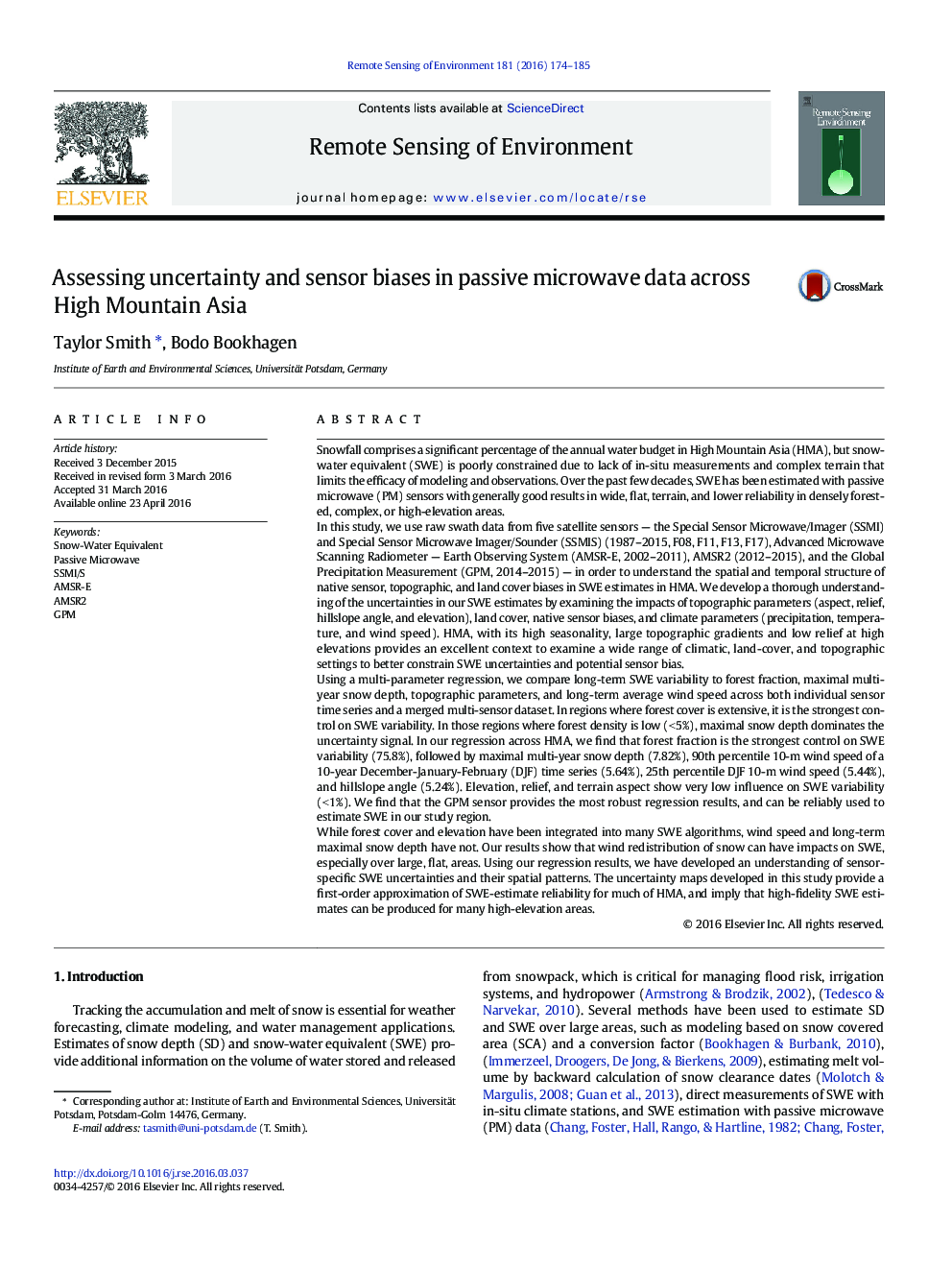| کد مقاله | کد نشریه | سال انتشار | مقاله انگلیسی | نسخه تمام متن |
|---|---|---|---|---|
| 6345308 | 1621219 | 2016 | 12 صفحه PDF | دانلود رایگان |
- Topography, land cover, and wind speed impact uncertainty in snow depth estimates.
- Forest cover and maximal snow depth are the strongest controls on uncertainty.
- Uncertainty is spatially variable, and heavily dependent on the individual platforms.
- GPM provides the most robust snow depth estimates of the platforms studied.
Snowfall comprises a significant percentage of the annual water budget in High Mountain Asia (HMA), but snow-water equivalent (SWE) is poorly constrained due to lack of in-situ measurements and complex terrain that limits the efficacy of modeling and observations. Over the past few decades, SWE has been estimated with passive microwave (PM) sensors with generally good results in wide, flat, terrain, and lower reliability in densely forested, complex, or high-elevation areas.In this study, we use raw swath data from five satellite sensors - the Special Sensor Microwave/Imager (SSMI) and Special Sensor Microwave Imager/Sounder (SSMIS) (1987-2015, F08, F11, F13, F17), Advanced Microwave Scanning Radiometer - Earth Observing System (AMSR-E, 2002-2011), AMSR2 (2012-2015), and the Global Precipitation Measurement (GPM, 2014-2015) - in order to understand the spatial and temporal structure of native sensor, topographic, and land cover biases in SWE estimates in HMA. We develop a thorough understanding of the uncertainties in our SWE estimates by examining the impacts of topographic parameters (aspect, relief, hillslope angle, and elevation), land cover, native sensor biases, and climate parameters (precipitation, temperature, and wind speed). HMA, with its high seasonality, large topographic gradients and low relief at high elevations provides an excellent context to examine a wide range of climatic, land-cover, and topographic settings to better constrain SWE uncertainties and potential sensor bias.Using a multi-parameter regression, we compare long-term SWE variability to forest fraction, maximal multi-year snow depth, topographic parameters, and long-term average wind speed across both individual sensor time series and a merged multi-sensor dataset. In regions where forest cover is extensive, it is the strongest control on SWE variability. In those regions where forest density is low (<Â 5%), maximal snow depth dominates the uncertainty signal. In our regression across HMA, we find that forest fraction is the strongest control on SWE variability (75.8%), followed by maximal multi-year snow depth (7.82%), 90th percentile 10-m wind speed of a 10-year December-January-February (DJF) time series (5.64%), 25th percentile DJF 10-m wind speed (5.44%), and hillslope angle (5.24%). Elevation, relief, and terrain aspect show very low influence on SWE variability (<Â 1%). We find that the GPM sensor provides the most robust regression results, and can be reliably used to estimate SWE in our study region.While forest cover and elevation have been integrated into many SWE algorithms, wind speed and long-term maximal snow depth have not. Our results show that wind redistribution of snow can have impacts on SWE, especially over large, flat, areas. Using our regression results, we have developed an understanding of sensor-specific SWE uncertainties and their spatial patterns. The uncertainty maps developed in this study provide a first-order approximation of SWE-estimate reliability for much of HMA, and imply that high-fidelity SWE estimates can be produced for many high-elevation areas.
Journal: Remote Sensing of Environment - Volume 181, August 2016, Pages 174-185
